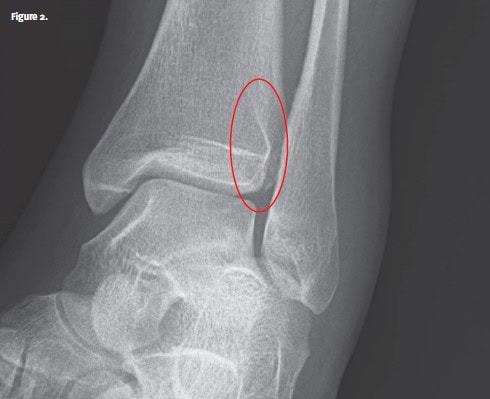Published on
Differential Diagnosis
- Lateral ankle sprain
- Fracture of the distal fibula
- Fracture of the lateral base of tibia at the syndesmosis
Diagnosis
The correct diagnosis in this case is a fracture of the lateral base of tibia at the syndesmosis. The image reveals fragmentation of the lateral base of the tibia at the syndesmosis with diffuse ankle swelling. Syndesmosis injuries occur when there is a disruption of the distal attachment of the tibia and fibula. These injuries occur commonly, especially with athletic activity. There are 4 classic fracture fragments: medial malleolus; anterior malleolus; lateral malleolus; and posterior malleolus.

What to Look For
- The syndesmosis is the articulation between the distal tibia and fibula and is comprised of 2 ligaments:
- The anterior-inferior tibiofibular ligament, which originates from anterolateral tubercle of tibia and inserts on anterior tubercle of fibula
- The posterior-inferior tibiofibular ligament, which originates from posterior tubercle of tibia and inserts on posterior part of lateral malleolus
- Evaluation of x-ray should inspect the origination and insertion points of these ligaments for disruption as a result of injury
Pearls for Urgent Care Management
- Evaluate for neurologic or vascular compromise
- Initial treatment includes splint immobilization (ankle at 90 degrees)
- Pain management should include ice, elevation, and pain medications
- Stable joint patterns likely will heal with immobilization alone
- Unstable joint patterns likely will require surgical intervention, and orthopedic referral is indicated
Download the article PDF: 30-Year-Old With Foot Inversion Injury
30-Year-Old With Foot Inversion Injury
1 2
